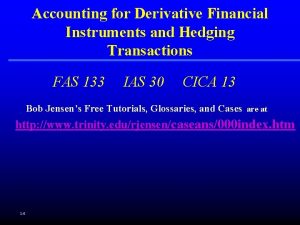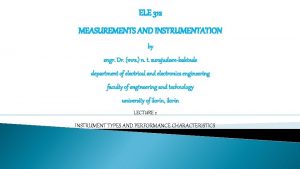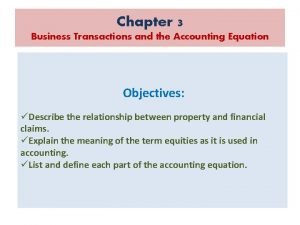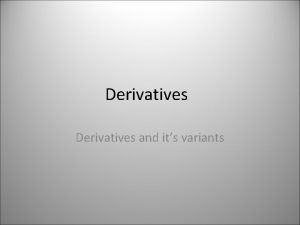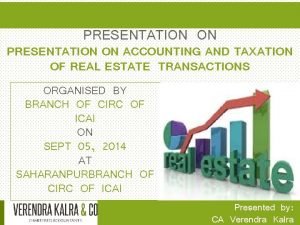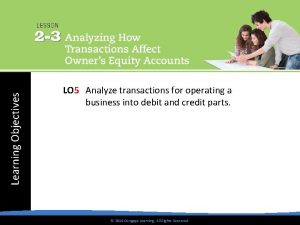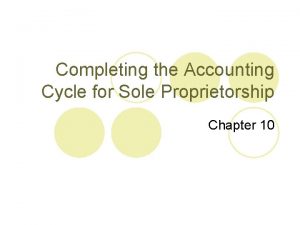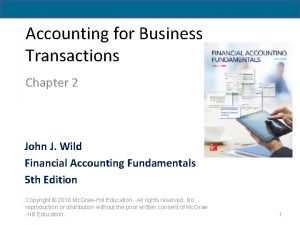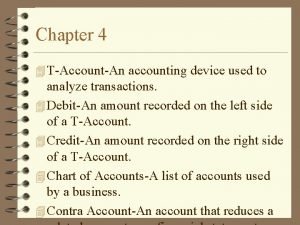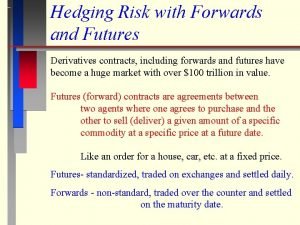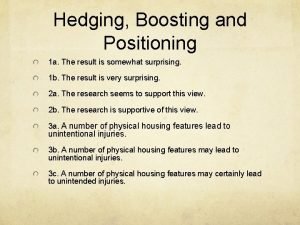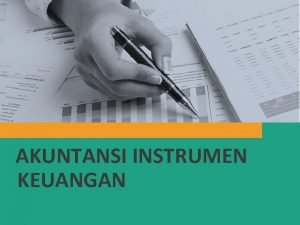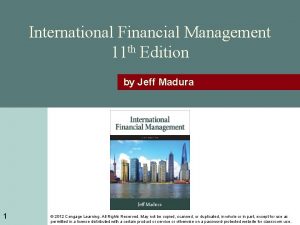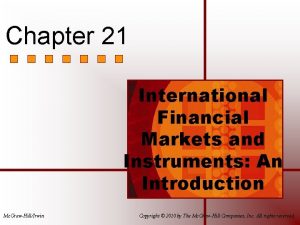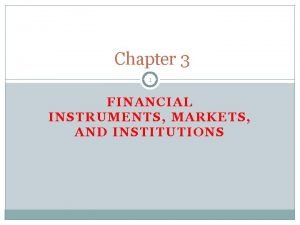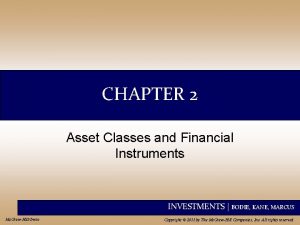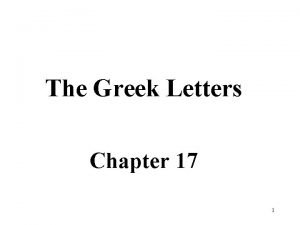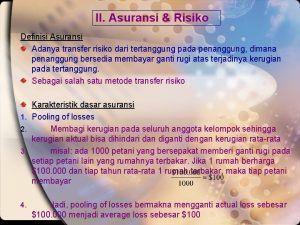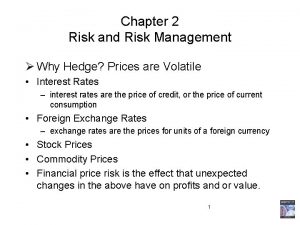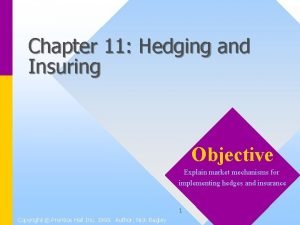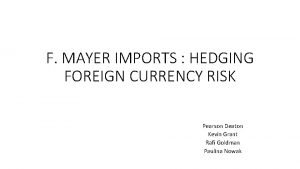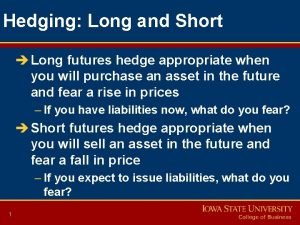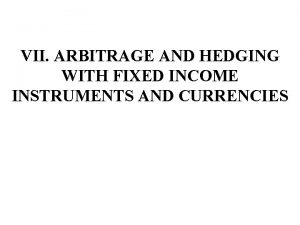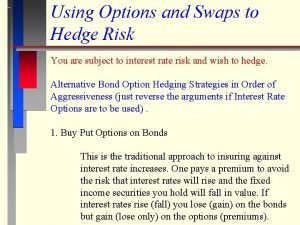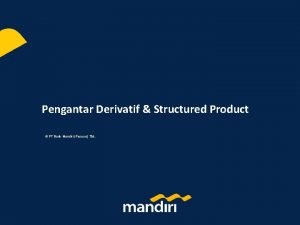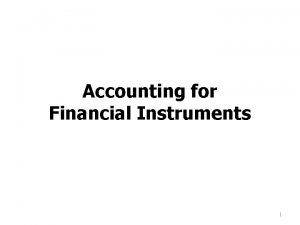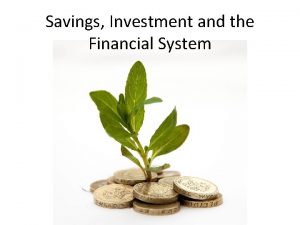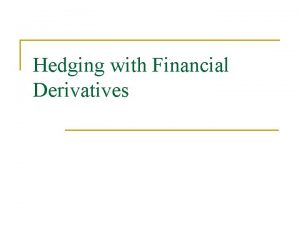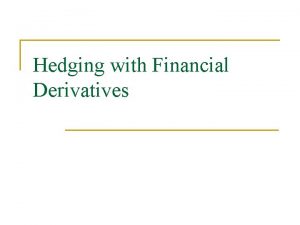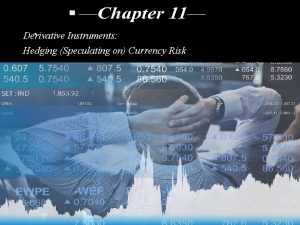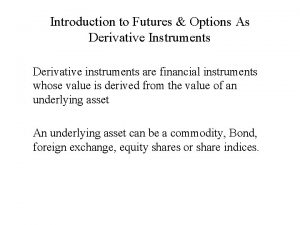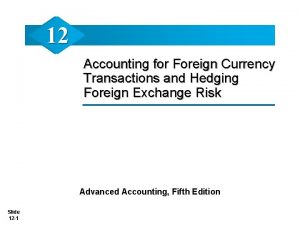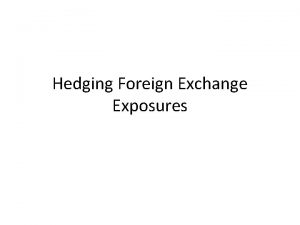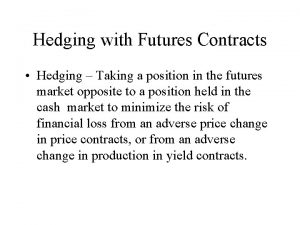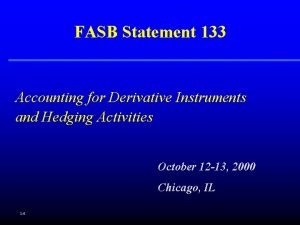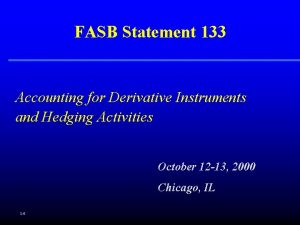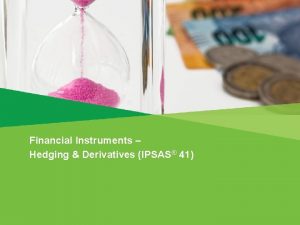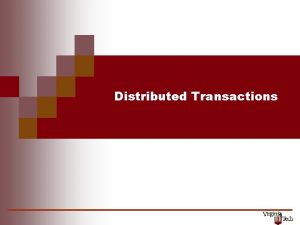Accounting for Derivative Financial Instruments and Hedging Transactions

















































- Slides: 49

Accounting for Derivative Financial Instruments and Hedging Transactions FAS 133 IAS 30 CICA 13 Bob Jensen’s Free Tutorials, Glossaries, and Cases are at http: //www. trinity. edu/rjensen/caseans/000 index. htm 1 -0

ACCOUNTING FOR DERIVATIVES Presentation by Bob Jensen Trinity University San Antonio, TX 78212 rjensen@trinity. edu http: //www. trinity. edu/rjensen/ 1 -1

REASONS FOR NEW STANDARDS Undisclosed Assets and Liabilities Unbooked Assets and Liabilities Meaningless Measures of Value & Risk Rise in Scandals in the 1980 s & 1990 s Complex Frauds --- Partnoy’s Fiasco Explosion of Swap Contracts Evolution Toward Fair Value Accounting 1 -2

PROBLEMS WITH NEW STANDARDS Complex Contracts & Technical Jargon Complex Scoping of Coverage --- NPNS Complex Hedge Accounting Rules Many Derivatives Are Difficult to Value Difficult to Find Embedded Derivatives Complex Effectiveness Testing Rules Continuous Stream --- DIG, Amendments Implementation Failures --- Freddie Mac, etc. Held-to-Maturity Interim Distortions Hedge Acctg. Denied to Most Macro Hedges 1 -3

Differences Between Standards FAS 133 vs. IAS 39 vs. CICA 13 Differences are relatively minor IAS 39 Macro Hedging Pending Amendment Listing of Major Differences http: //www. trinity. edu/rjensen/caseans/canada. htm . 1 -4

Hedge Accounting Section Objectives After completing this section, you should be able to: l Determine whether a contract is scoped into the standards and, if so, whether it is – Qualified for Hedge Accounting – Treated as a cash flow, fair value, or FX hedge 1 -5 l Understand the basic journal entries l Cry out loud if forced to implement the standards

FOUR CORNERSTONES n Derivatives are contracts that create rights and obligations that meet the definitions of assets and liabilities n Fair value is the only relevant measure for derivatives n Value risk can be hedged into cash flow risk, and cash flow risk can be hedged into value risk, but both risks cannot simultaneously be eliminated. n Hedge effectiveness tests can be varied with the type of risk being hedged. 1 -6

KEY ASPECTS OF THE STANDARDS n Most derivatives are reported at fair value on balance sheet n Changes in fair value for derivatives not designated and qualifying in a hedging relationship are recorded in earnings n Hedge accounting is provided for the change in value of derivatives designated and qualifying as: n 1 -7 l Fair value hedges l Cash flow hedges l Foreign currency hedges Hedge effectiveness tests may be tough hurdles over time

DERIVATIVES IMPLEMENTATION GROUP (DIG) n DIG is made up of FASB staff members, Big 5 members and Industry professionals. Active DIG observers include the SEC and certain regulators. n DIG’s mandate is to assist the FASB in answering implementation questions by identifying practice issues that arise from applying Statement 133 and to advise the FASB staff on how to resolve the issues. n Issues are discussed by DIG, tentatively concluded by the FASB staff and posted on the FASB website (www. fasb. org) for two months before being presented to the Board for negative clearance. n DIG Site http: //www. fasb. org/derivatives/ 1 -8

Bob Jensen’s Flow Chart http: //www. trinity. edu/rjensen/acct 5341/speakers/133 flow. htm n Flow chart for deciding whether derivative is scoped into FAS 133 n Flow chart for deciding how to account for a derivative financial instrument qualified for hedge accounting. Cash Flow Hedge (booked item vs. forecasted transact. ) Fair Value Hedge (booked item vs. firm commitment) Foreign Currency (FX) Hedge (fair value vs. cash flow) 1 -9

DERIVATIVE DEFINITION ¶ 6– 16 n The definition is based on distinguishing characteristics n A derivative instrument is a contract with all three of the following characteristics (¶ 6): l Underlying and either a notional amount or a payment provision or both l Relatively small initial net investment l Net settlement or its equivalent (excludes most short sales & Take-Or-Pays, but see FAS 133 Paragraph 290) n n 1 -10 Definition includes freestanding as well as embedded derivative instruments A number of exclusions exist

FREESTANDING DERIVATIVES Overview n Statement 133 created a new definition of the term derivative n Some instruments that are not usually considered derivatives are included (e. g. certain purchase/sales contracts) n The definition is based on certain distinguishing characteristics. n Certain scope exceptions exist; not everything that meets the definition of a derivative is subject to the requirements of Statement 133. 1 -11

FREESTANDING DERIVATIVES Three Characteristics ¶ 6– 9 and 57 A derivative instrument is a contract with all three of the following characteristics: 1. Underlying and either a notional amount or a payment provision or both 2. No initial net investment or smaller initial net investment than contracts with similar responses to changes in market factors 3. Net settlement or its equivalent 1 -12

FREESTANDING DERIVATIVES Characteristic 1—Underlying ¶ 7 and 57(a) An underlying is a variable, such as: l l 1 -13 An interest rate (e. g. , LIBOR) The price of a security or commodity (e. g. , price of a share of ABC stock or a bushel of wheat) l A foreign exchange rate (e. g. , Euro/U. S. $ spot rate) l A measure of creditworthiness (e. g. , Moody’s) l An index on any of above or other (e. g. , S&P 500, CPI) l Other specific items

FREESTANDING DERIVATIVES Characteristic 1—Notional Amount ¶ 7 A notional amount is a number of: l Currency units l Shares l Bushels l Pounds l Other units Notional amount is used to determine the settlement amount (for example, a price x a number of shares) 1 -14

FREESTANDING DERIVATIVES Characteristic 1—Examples of Underlyings and Notional Amounts Derivative - Stock option Underlying - Stock price - Currency forward - Exchange rate Notional Amount - Number of shares - Number of currency units - Commodity future - Commodity price - Number of commodity units - Interest rate swap - Interest index 1 -15 - Dollar amount

FREESTANDING DERIVATIVES Characteristic 1— Payment Provision ¶ 7 A payment provision specifies a fixed or determinable settlement if the underlying behaves in a specified way. For example: if interest rates increase by say 300 basis points then payment of an applicable amount would be required 1 -16

FREESTANDING DERIVATIVES Characteristic 2— Initial Net Investment ¶ 8 and 57(b) A derivative requires either: l l No initial net investment A smaller initial net investment than other types of contracts that have a similar response to changes in market factors A derivative does not require an initial net investment of the notional amount An exchange of currencies is not a net investment 1 -17

FREESTANDING DERIVATIVES Characteristic 3—Net Settlement ¶ 9 and 57(c) There are 3 ways to meet the net settlement requirement: 1. Net settlement explicitly required or permitted by the contract (transfer of cash or other assets) 2. Net settlement by a market mechanism outside the contract (e. g. , futures exchange) 3. Delivery of a derivative or an asset that is readily convertible to cash 1 -18

FREESTANDING DERIVATIVES Characteristic 3—Readily Convertible to Known Amounts of Cash ¶ 9 and 57(c) Readily convertible assets have: l l Interchangeable (fungible) units Quoted prices available in an active market that can rapidly absorb the quantity held by the entity without significantly affecting the price For example: l 1 -19 Public securities, commodities, and foreign currencies

FREESTANDING DERIVATIVES Exceptions ¶ 10 and 58 The following are not subject to Statement 133: l “Regular-way” security trades l Normal purchases and normal sales l Traditional insurance contracts l Most financial guarantee contracts l OTC contracts with certain underlyings l 1 -20 Derivatives that are an impediment to sales accounting

FAS 138 Scope-Excluded Contracts Normal purchase/sale exception expanded to include: n Contracts that permit net settlement (9 a) n Contracts that have a market mechanism to facilitate net settlement (but note FAS 138) As long as it is probable contracts will not settle net and will result in physical delivery (but note FAS 138 and FAS 149) 1 -21

FAS 138 Scope-Excluded Contracts (Cont’d) Net settlement of similar contracts should be rare Excluded from exception: • Contracts that require cash settlement or otherwise settle periodically • Contracts that have price based on underlying unrelated to asset sold or purchased(1) • Contracts denominated in foreign currency not meeting embedded derivative separation exception rules of paragraphs 15(a) and 15(b) (1) 1 -22 (1) May be considered compound derivatives

FREESTANDING DERIVATIVES Exceptions OTC Contracts with Certain Underlyings ¶ 10(e) and 58(c) Climatic variables: l Temperature l Rain or snowfall totals l Wind speed Geological variables: l Earthquake severity (Richter scale) Other physical variables 1 -23

FREESTANDING DERIVATIVES Exceptions—OTC Contracts with Certain Underlyings ¶ 10(e) and 58(c) The price or value of nonfinancial assets of one of the parties that is not readily convertible to cash or the price or value of nonfinancial liabilities of one of the parties that does not require delivery of readily convertible assets l l 1 -24 Option to purchase or sell real estate owned by one party (even if it can be net settled) Firm commitment to sell machinery (if unique) owned by one party (even if it can be net settled)

FREESTANDING DERIVATIVES Exceptions OTC Contracts with Certain Underlyings ¶ 10(e) and 58(c) Exceptions include specified volumes of sales or service revenues of one of the parties. For example: 1 -25 l Leases based on sales of the lessee l Royalty agreements

FREESTANDING DERIVATIVES Contracts Not Considered Derivatives for Purposes of Statement 133, ¶ 11 n Instruments indexed to an entity’s own stock and classified in stockholders’ equity n Stock-based compensation covered by Statement 123 (issuer only) n Contingent consideration in a business combination covered by Opinion 16 (purchaser only) 1 -26

EMBEDDED DERIVATIVES Definition ¶ 12 n Embedded derivatives are implicit or explicit terms that affect the cash flows or value of other exchanges required by a contract in a manner similar to a derivative n The combination of a host contract and an embedded derivative is referred to as a hybrid contract n Examples of hybrid contracts are: l Structured notes l Convertible securities l Securities with caps, floors, or collars 1 -27

EMBEDDED DERIVATIVES When Does a Contract Have an Embedded Derivative Subject to This Statement? ¶ 12 Yes No Would it be a derivative if it was freestanding? Yes No Do Not Apply This Statement 1 -28 Is it clearly and closely related to the host contract? Yes No Apply This Statement Is the contract carried at fair value through earnings?

EMBEDDED DERIVATIVES Clearly and Closely Related—General ¶ 12 and 60– 61 Clearly and closely related refers to: l Economic characteristics l Risks Factors to consider: l The type of host l The underlying See Flow Chart http: //www. trinity. edu/rjensen/acct 5341/speakers/133 flow. htm 1 -29

EMBEDDED DERIVATIVES Clearly and Closely Related—Underlyings Type of Host 1 -30 Underlying Debt Interest Inflation Creditworthiness Equity Price of share in entity Lease Inflation Interest

EMBEDDED DERIVATIVES Clearly and Closely Related Paragraph 61 provides guidance for determining whether the economic characteristics and risks of the embedded derivative are clearly and closely related to the economic characteristics and risks of the host contract. 1 -31

FAIR VALUE HEDGE ¶ 20– 22 A fair value hedge is a hedge of the exposure to a change in fair value of a recognized asset or liability or of an unrecognized firm commitment attributable to a particular risk. Key aspects: l l 1 -32 Hedged item is exposed to price risk For a highly effective hedge, there must be offsetting fair value changes for hedged item and hedging instrument Changes in fair value of hedged item and hedging instrument are recorded in earnings Basis of hedged item is adjusted by the change in value

FAIR VALUE HEDGE ACCOUNTING Key concepts: n Derivatives are always adjusted on the balance sheet at fair value (i. e. , marked-to-market) (¶ 17) n n In qualified hedge accounting, the offset to changes in the hedging derivative is OCI for cash flow hedges but not for fair value hedges. For a qualified fair value hedge, the offset is = “Firm Commitment” for a purchase contract with a contracted price = “Hedged Item” carrying value if the hedged item such as inventory is already on the books at historical cost = “P&L” current earnings if the hedged item such as inventory is already on the books at fair value 1 -33

FAIR VALUE HEDGE ACCOUNTING For Hedged Item Booked at Historical Cost Accounting Model Measurement of Derivative Change in Fair Value Measurement of Hedged Item Offsetting Gain or Loss Attributable to Risk Being Hedged (1) Ineffectiveness affects net earnings 1 -34 Earnings Changes Offset (1)

CASH FLOW HEDGE ¶ 29– 31 A cash flow hedge is a hedging relationship where the variability of the hedged item’s cash flows is offset by the cash flows of the hedging instrument. Key aspects: 1 -35 • Hedged item may be a forecasted transaction with no contracted future price (i. e. , not a firm commit. ) • Effective portion of derivative’s gain or loss reported in OCI • • Earnings recognition matches hedged transaction Ineffective gain or loss recorded in earnings

CASH FLOW HEDGE ACCOUNTING n Derivative instrument recorded at fair value, effective portion through OCI, ineffective through earnings n Amounts in OCI recognized in earnings when hedged transaction impacts earnings under FAS 133 but not under IAS 39. In other words, IAS 39 requires basis adjustment when the derivative expires whereas FAS 133 carries OCI forward until hedged item is disposed of in a transaction. 1 -36

Accounting Model CASH FLOW HEDGE ACCOUNTING Change in Fair Value Effective Ine (1) ffe cti v e Earnings (1) Based on Timing of Earnings Impact of Hedged Item (interest, cost of sales, depreciation) 1 -37 OCI Equity Measurement of Derivative

FOREIGN CURRENCY HEDGE ¶ 36– 42 (as amended by FAS 138) The Board intended to increase the consistency of hedge accounting guidance by broadening the scope of eligible foreign currency hedges. At the same time, the Board chose to continue certain prior practices. Key aspects: l Includes hedges of cash flow, fair value, and net investments in foreign operations l Carries forward the functional currency concept from Statement 52 l Permits limited use of nonderivative instruments l Expands hedge accounting, particularly forecasted transactions and tandem currency hedges 1 -38

Hedging Instruments n For a fair value hedge of foreign exchange risk related to AFS securities or a recognized foreign-currency-denominated debt instrument, an entity can only use a derivative instrument n For a fair value hedge of foreign exchange risk related to a firm commitment, an entity can use either a derivative or a nonderivative instrument n For a cash flow hedge of a forecasted foreign currency denominated transaction (including forecasted intercompany transactions, recognized foreign-currency-denominated debt instruments and firm commitments accounted for as forecasted transactions), an entity can only use a derivative instrument n For a hedge of a net investment in a foreign operation, an entity can use either a derivative or a non-derivative instrument 1 -39

OBJECTIVE OF HEDGE ACCOUNTING Timing of gain/loss recognition on hedging instrument and hedged item Periods 1 Hedged Item Derivative Total $ -0 - (1) $(20) 20 (2) -0 - $20 1 -40 2 $(20) 20 $(20) $ -0 -

Change to Forward/Futures Power. Point Show And Compare Examples 1 and 4 Go to 02 For. Fut. Calgary. ppt End of Calgary Introduction 1 -41

CASE 1 Cash Flow Hedge of Forecasted Inventory Sale n ABC is hedging the risk of changes in cash flows related to a forecasted sale of 100, 000 bushels of Commodity A to be sold at the end of period 1. The inventory carrying value is $1 million, and current market value is $1. 1 million n On the first day of period 1, ABC enters into Derivative Z to sell 100, 000 bushels at $1. 1 million at the end of period n At hedge inception, the derivative is at-the-money (fair value is 0) n All terms of the commodity and the derivative match (i. e. , no expected ineffectiveness) n On last day of Period 1, fair value of Derivative Z increased by $25, 000 and expected sales price of 100, 000 bushels of Commodity A decreased $25, 000 n From Example 4, Appendix B of Standard 1 -42

CASE 1 Cash Flow Hedge of Forecasted Inventory Sale Journal entries at end of period 1 Derivative Z 25, 000 OCI 25, 000 To record Derivative Z at fair value Cash Derivative Z 25, 000 To record settlement of Derivative Z 1 -43 25, 000

CASE 1 Cash Flow Hedge of Forecasted Inventory Sale Journal entries at end of period 1 Cash 1, 075, 000 CGS 1, 000 Revenue 1, 075, 000 Inventory 1, 000 To record inventory sale OCI 25, 000 Earnings 25, 000 To reclassify amount in OCI to earnings upon inventory sale 1 -44

CASE 1 Cash Flow Hedge of Forecasted Inventory Sale Forecasted cash flows: $1, 100, 000 Actual cash flows: Derivative $ Sale of inventory Total 25, 000 1, 075, 000 $1, 100, 000 The variability of cash flows related to the forecasted inventory sale is offset by change in value of derivative. 1 -45

CASE 2 Fair Value Hedge of Inventory n ABC has 1, 000 bushels of a Commodity with a fair value of $1. 1 million and a carrying value of $1. 0 million n ABC wants to hedge overall fair value of the Commodity n On 1/1/X 1, ABC enters into an at-the-money “matching” derivative to hedge the changes in fair value of the 1, 000 bushels of the Commodity 1 -46

CASE 2 (Cont’d) Fair Value Hedge of Inventory n Effectiveness will be assessed by comparing entire change in fair value of derivative to change in market price of inventory (time value will be ignored for illustration purposes only) n On 1/31/X 1, the fair value of the derivative has increased by $25, 000 and the fair value of the inventory has decreased by $25, 000 1 -47

CASE 2 Fair Value Hedge of Inventory Journal entries at end of period: Derivative 25, 000 Earnings 25, 000 To record derivative at fair value Earnings 25, 000 Inventory To record loss on hedged inventory 1 -48 25, 000
 What is hedge accounting
What is hedge accounting Financial accounting and accounting standards chapter 1
Financial accounting and accounting standards chapter 1 Role and responsibility of management accountant ppt
Role and responsibility of management accountant ppt Active instruments and passive instruments
Active instruments and passive instruments Indicating instruments and instruments with a signal output
Indicating instruments and instruments with a signal output Problem 3-1 balancing the accounting equation
Problem 3-1 balancing the accounting equation Financial derivative definition
Financial derivative definition Analyzing accounting concepts and practices chapter 2
Analyzing accounting concepts and practices chapter 2 1. an accounting device used to analyze transactions
1. an accounting device used to analyze transactions Guidance note on accounting for real estate transactions
Guidance note on accounting for real estate transactions 8. an accounting device used to analyze transactions.
8. an accounting device used to analyze transactions. Sole proprietorship accounting transactions
Sole proprietorship accounting transactions Analysis of business transaction
Analysis of business transaction 4. an accounting device used to analyze transactions.
4. an accounting device used to analyze transactions. A form for recording transactions in chronological order
A form for recording transactions in chronological order Hedging in forward market
Hedging in forward market Hedging and boosting
Hedging and boosting Hedged item and hedging instrument examples
Hedged item and hedging instrument examples Hedging receivables and payables
Hedging receivables and payables Hedging strategies using futures and options
Hedging strategies using futures and options International financial markets and instruments
International financial markets and instruments Financial markets instruments and institutions
Financial markets instruments and institutions Chapter 2 asset classes and financial instruments
Chapter 2 asset classes and financial instruments Hedging in academic writing exercises
Hedging in academic writing exercises Vega greek letter
Vega greek letter Rewrite in academic style
Rewrite in academic style Transfer risiko adalah
Transfer risiko adalah Hedging language
Hedging language Hedging adalah
Hedging adalah Cautious language
Cautious language Hedging manages risk that are manageable
Hedging manages risk that are manageable Main objective of hedging
Main objective of hedging Hedging strategies using futures
Hedging strategies using futures Tailing hedge
Tailing hedge F. mayer imports: hedging foreign currency risk
F. mayer imports: hedging foreign currency risk Oil hedging definition
Oil hedging definition Cattle hedging strategies
Cattle hedging strategies Contoh instrumen derivatif
Contoh instrumen derivatif Long hedge and short hedge
Long hedge and short hedge Hedging interest rate risk with futures
Hedging interest rate risk with futures Hedging approach of working capital
Hedging approach of working capital Imperfect hedge
Imperfect hedge Fixed income hedging
Fixed income hedging Hedging credit risk with options
Hedging credit risk with options Hedging adalah
Hedging adalah What is futures trading
What is futures trading Static hedging of exotic options
Static hedging of exotic options Slfrs 9 financial instruments
Slfrs 9 financial instruments Types of financial instruments
Types of financial instruments Finance instruments
Finance instruments
